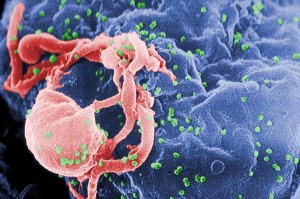HIV research has made headlines around the world recently, featured significantly in the science and health sections of many leading media outlets, including the BBC, the Guardian and the New York Times.
‘Early treatment ‘cures’ second US HIV-positive baby’ BBC News 6 March
The first news story comes from an AIDS conference in Boston, announcing that a baby born to a HIV-positive mother has been cleared of the virus following early treatment with antiretroviral therapy (ART). As the mother was not undergoing treatment for HIV during pregnancy, the newborn was treated with a high dose triple combination of ART (AZT, 3TC and NVP) within hours of birth. The normal approach for newborns would be lower doses of two drugs, with aggressive treatment paused until confirmation of HIV infection.
Virus infection was confirmed by a positive HIV DNA test and a detectable viral load of 217 copies/ml in the blood (36 hours after birth), with 32 copies/ml detected in the cerebrospinal fluid on day 6. After 11 days, the viral load was undetectable in the baby’s plasma, and remains undetectable in the baby, now 9 months old.
This announcement follows last year’s reporting of the so-called ‘Mississippi baby’, the first baby apparently cured by early drug therapy, although infection has not been confirmed. Many headlines have again focused on the word ‘cure’ and comments such as there is “little doubt the treatment works” (McNeil Jr., NY Times) are rather pre-emptive. Assuming a ‘cure’ based on virological assays has limitations, the baby is still on ART and the virus may re-appear when treatment is removed. Researchers have planned a larger clinical trial to test if the new approach can be repeated.
For information on ART and clinical trials, see this article: Towards an HIV cure: science and debate from the International AIDS Society 2013 symposium
‘Study Gives Hope of Altering Genes to Repel H.I.V’ NY Times 5 March
A paper from the New England Journal of Medicine has featured extensively in the news, focusing on the safety of “gene editing” CCR5, the major coreceptor for HIV. 12 HIV patients were enrolled in the trial, which involved removal of patient’s CD4 T cells and modification of the CCR5 gene using a zinc-finger nuclease. This rendered the CCR5 gene permanently dysfunctional. The CD4 T cells were then infused back into patients, with approximately 20% of the CD4 T cells containing the ‘shielding mutation’, known as CCR5-delta32.
Patients were taken off medication for four weeks, with a resulting increase in HIV viral load and fall in T cell count. However, the decline in modified T cells was significantly less than the unmodified T cells, indicating resistance to HIV infection. The modified CD4 T cells could be found in the blood months later. The article is an interesting finding and highlights the feasibility and safety of such an approach.
You can read more about this approach, and other innovative strategies, in a recent review in Retrovirology: A cure for AIDS: a matter of timing?
‘Rare case of female-to-female HIV infection reported in US’ The Independent 14 March
The Centre for Disease Control and Prevention in the US, has reported a rare case of female-to female transmission of HIV. The report describes a likely female-to female transmission of HIV in a discordant couple (one negative, one positive) who had unprotected sex during a 6 month monogamous relationship. The HIV-positive partner had stopped ART in November 2010. Previous studies in WSW (women who have sex with women) transmission have often proved difficult due to other factors, such as intravenous drug use or a sexual history with men.
The researchers performed phylogenetic analysis on the viruses from both women, screening HIV-1 gag, pol and env sequences, identifying >98% sequence identity. This showed that the viruses between the women were virtually identical. Although female-to-female transmission is possible, cases have been rare and difficult to ascertain, meaning this report is unique, particularly regarding the use of phylogenetics to confirm the HIV source.
These articles represent some of the HIV-related news stories in the last month. It is interesting that many articles focus on announcements from individual patient cases rather than peer-reviewed research, but nevertheless it is still important that new HIV research continues to remain in the media spotlight.
Latest posts by Liam Prestwood (see all)
- Beyond the Headlines: HIV in the news - 29th April 2014
- Far from black and white: Insights into the diversity of SIV - 22nd October 2013
Comments